Toxic Volcano Tornados Spotted in Iceland
By Becky Oskin, Senior Writer | September 08, 2014

|
|
Volcano tornados spotted above lava on Sept. 1 at Iceland's Holuhraun eruption. Credit: Einar Gudmann |
The toxic tornadoes were spotted in a poisonous cloud of sulfur dioxide gas spewing from Iceland's Holuhraun lava flow on Sept. 3. One narrow, swirling column stretched 3,300 feet (about 1 kilometer) into the air. A remotely monitored infrared camera caught the dramatic whirlwinds on video.
"We haven't seen anything like this before," said Fred Prata, chief technology officer at Nicarnica Aviation in Kjeller, Norway, the inventor of the infrared camera used for the images. "I was quite surprised to see it."
Nicarnica's infrared camera can track ash clouds from planes, but is now undergoing a ground-based test run in Iceland through the FutureVolc project, an international collaboration to monitor Europe's natural hazards.
Tornadoes born from fires and volcanoes are completely different beasts from the lethal tornadoes spawned by powerful thunderstorms. A true tornado spins up in the atmosphere and requires colliding cool and dry air fronts, wind shear (rotating air) and warm, moist air near the ground.
But narrow volcano and fire whirlwinds rise from ground level, not from high in the sky. In these terrible twisters, superheated dry air starts spinning faster and faster until the vortex tightens into a tall, tornadolike column. (The phenomenon is similar to a figure skater who rotates faster by tucking her arms closer to her body.)
On Sept. 3, 2014, gas tornadoes (seen here in infrared) spewed from Iceland's Holuhraun lava flow, near the Bardarbunga volcano.
Credit: Nicarnica Aviation, Screengrab
The Icelandic Met Office has warned of the risk of volcano tornadoes, though its official terminology refers to the phenomenon as "wind anomalies from thermal convection." Last week, officials arrested tourists who ventured too close to the hazard zone. Scientists and journalists were also asked to leave the lava field the same day the volcano tornadoes appeared, due to the hazardous conditions.
Despite the risks, professional photographer Einar Gudmann also caught the volcano tornadoes in action on Sept. 1, and posted photos on his website.
Iceland's eruption blazed to life on Aug. 28 north of Bardarbunga volcano, in the Holuhraun lava field. The basalt lava flow is now plowing through the Jokulsa a Fjollum River as of Sept. 7, diverting but not blocking the channel. The glowing lava covers 7.3 square miles (19 square km).
source
~~~~~~~~~~~~~~~~~~~~~~~~~~~~~~~~~~~~~~~~~~~~~~~~~~~~~~~~~~~~~~~~~~~~~~~~~
Continuing subsidence in Barðarbunga
Fyrst birt: 08.09.2014 16:56
Flokkar: Volcano

Bardarbunga volcano on Sept. 5. (Picture: Magnus Tumi Gudmundsson)
A surveillance flight over the Bardarbunga volcano this morning
revealed continuing subsidence of the 850 metre thick glacial ice which
covers the caldera beneath. Strong seismic activity is still detected
around the caldera; the last one, a magnitude 5.0 earthquake occurred at
14.47 GMT.
Following a surveillance flight last Friday over the Bardarbunga
caldera, when measurements revealed up to 15 meter subsididence in the
center of the caldera, another flight was organized this morning.
The results show that the downward movement continues; since Friday the subsidence has increased by 2.5 - 3.0 metres, or 80-90 centimeters per day. "The events in Bardarbunga can only be described as a slow caldera collapse," says statement on the University of Iceland´s Institute of Earth Sciences´ website. The subsidence is the largest one measured in an Icelandic volcano.
These events are belived to occur in relation to the magma flow out of a chamber, thought to be situated beneath the caldera in Bardarbunga, as magma has been flowing to the north, feeding the effusive eruption in Holuhraun which started last week.
According to a status report issued Saturday, by the Icelandic Civil Protection Agency´s Scientific Advisory Board, the initial measurements from Friday showed dramatic changes on the surface of the glacier above the caldera, corresponding to a volume change of 0.25 cubic kilometres, or 250 million cubic meters.
bjornm@ruv.is
Below, the preliminary result of todays surveillance flight, titled: Bardarbunga - subsidence of glacial surface (University of Iceland/Institute of Earth Sciences.

The results show that the downward movement continues; since Friday the subsidence has increased by 2.5 - 3.0 metres, or 80-90 centimeters per day. "The events in Bardarbunga can only be described as a slow caldera collapse," says statement on the University of Iceland´s Institute of Earth Sciences´ website. The subsidence is the largest one measured in an Icelandic volcano.
These events are belived to occur in relation to the magma flow out of a chamber, thought to be situated beneath the caldera in Bardarbunga, as magma has been flowing to the north, feeding the effusive eruption in Holuhraun which started last week.
According to a status report issued Saturday, by the Icelandic Civil Protection Agency´s Scientific Advisory Board, the initial measurements from Friday showed dramatic changes on the surface of the glacier above the caldera, corresponding to a volume change of 0.25 cubic kilometres, or 250 million cubic meters.
bjornm@ruv.is
Below, the preliminary result of todays surveillance flight, titled: Bardarbunga - subsidence of glacial surface (University of Iceland/Institute of Earth Sciences.

And for a very cool series of images, go here to view them: LINK




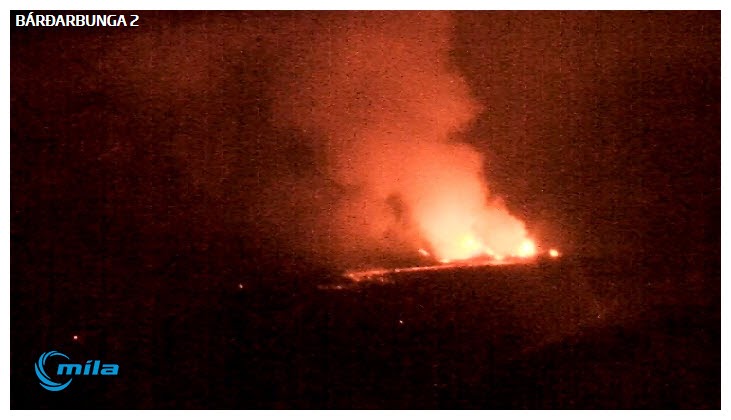









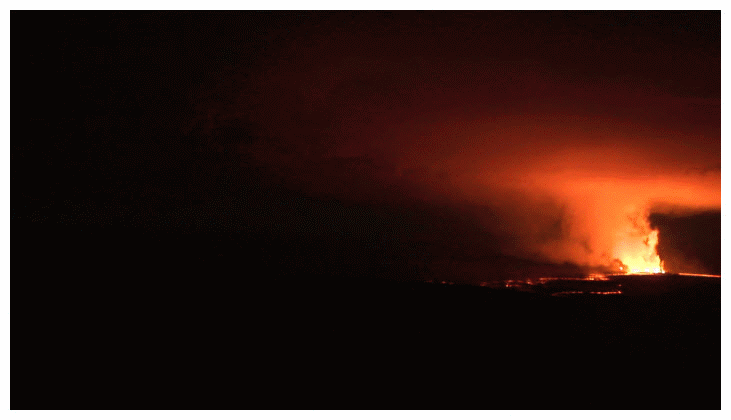
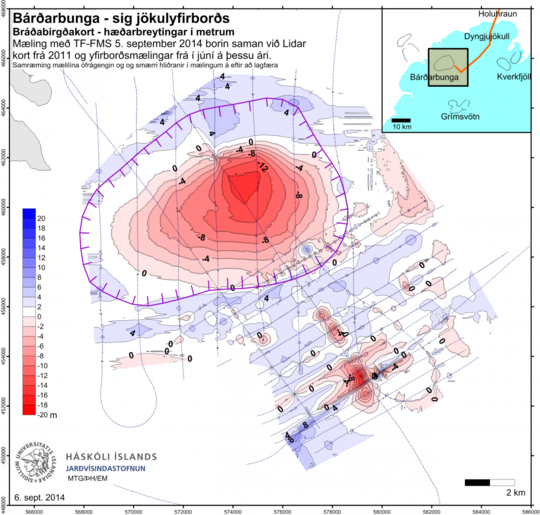
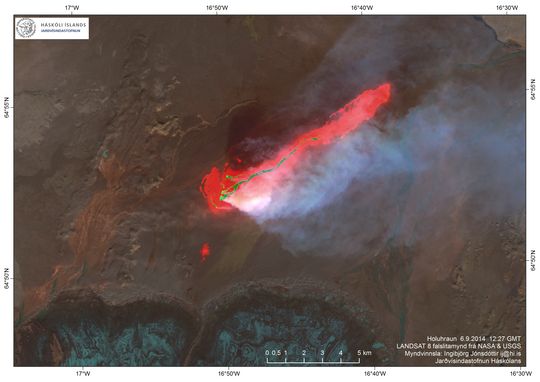
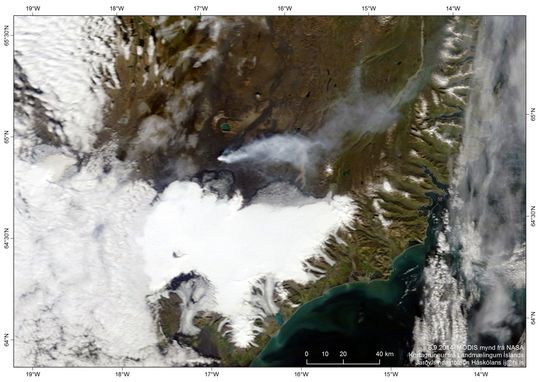
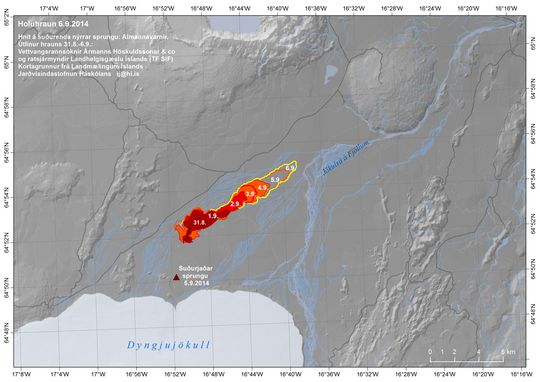 Institute of Earth Sciences University of Iceland 6.9.2014: South
coordinates from surveillance flight. Edges of lava 31.8-6.9. based on
radar images from TF-SIF of the Coast Guard and GPS measurements from
the field (IES). Map base from the National Land Survey.
Institute of Earth Sciences University of Iceland 6.9.2014: South
coordinates from surveillance flight. Edges of lava 31.8-6.9. based on
radar images from TF-SIF of the Coast Guard and GPS measurements from
the field (IES). Map base from the National Land Survey.